初中英语人教版八年级上册不定代词知识点讲解
八年级不定代词知识点归纳总结
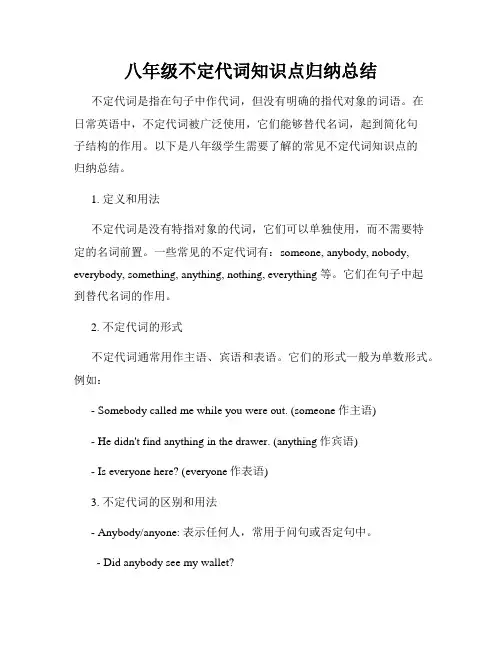
八年级不定代词知识点归纳总结不定代词是指在句子中作代词,但没有明确的指代对象的词语。
在日常英语中,不定代词被广泛使用,它们能够替代名词,起到简化句子结构的作用。
以下是八年级学生需要了解的常见不定代词知识点的归纳总结。
1. 定义和用法不定代词是没有特指对象的代词,它们可以单独使用,而不需要特定的名词前置。
一些常见的不定代词有:someone, anybody, nobody, everybody, something, anything, nothing, everything 等。
它们在句子中起到替代名词的作用。
2. 不定代词的形式不定代词通常用作主语、宾语和表语。
它们的形式一般为单数形式。
例如:- Somebody called me while you were out. (someone作主语)- He didn't find anything in the drawer. (anything作宾语)- Is everyone here? (everyone作表语)3. 不定代词的区别和用法- Anybody/anyone: 表示任何人,常用于问句或否定句中。
- Did anybody see my wallet?- I don't think anyone can solve this problem.- Somebody/someone: 表示某人,用于肯定句。
- Somebody left their jacket in the classroom.- Nobody/no one: 表示没有人,用于否定句。
- Nobody wants to go to the party.- Everybody/everyone: 表示每个人,用于肯定句。
- Everyone is excited about the field trip tomorrow.4. 不定代词与“every”和“some”连用- Everybody/everyone: 指所有人,强调集体整体。
初中英语人教新目标八年级上册Unit 1 重点语法解析
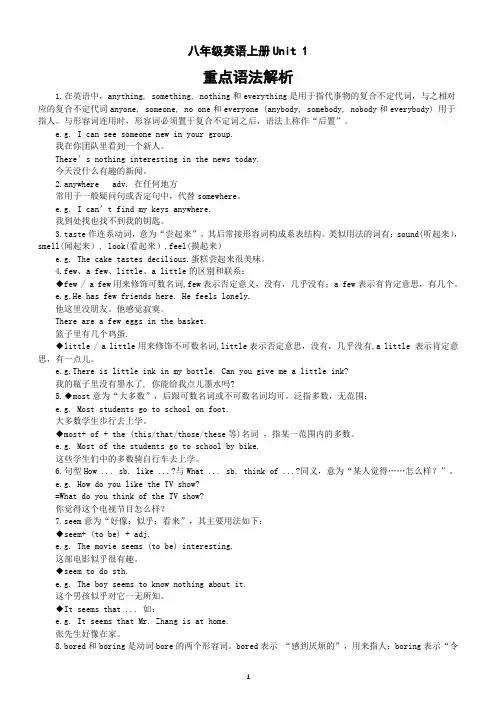
八年级英语上册Unit 1重点语法解析1.在英语中,anything, something, nothing和everything是用于指代事物的复合不定代词,与之相对应的复合不定代词anyone, someone, no one和everyone (anybody, somebody, nobody和everybody) 用于指人。
与形容词连用时,形容词必须置于复合不定词之后,语法上称作“后置”。
e.g. I can see someone new in your group.我在你团队里看到一个新人。
There’s nothing interesting in the news today.今天没什么有趣的新闻。
2.anywhere adv. 在任何地方常用于一般疑问句或否定句中,代替somewhere。
e.g. I can’t find my keys anywhere.我到处找也找不到我的钥匙。
3.taste作连系动词,意为“尝起来”,其后常接形容词构成系表结构。
类似用法的词有:sound(听起来),smell(闻起来), look(看起来),feel(摸起来)e.g. The cake tastes decilious.蛋糕尝起来很美味。
4.few、a few、little、a little的区别和联系:◆few / a few用来修饰可数名词,few表示否定意义,没有,几乎没有;a few表示有肯定意思,有几个。
e.g.He has few friends here. He feels lonely.他这里没朋友。
他感觉寂寞。
There are a few eggs in the basket.篮子里有几个鸡蛋.◆little / a little用来修饰不可数名词,little表示否定意思,没有,几乎没有,a little 表示肯定意思,有一点儿。
e.g.There is little ink in my bottle. Can you give me a little ink?我的瓶子里没有墨水了, 你能给我点儿墨水吗?5.◆most意为“大多数”,后跟可数名词或不可数名词均可。
英语八年级上册知识讲义 不定代词(Units 1-2语法归纳)-人教新目标版
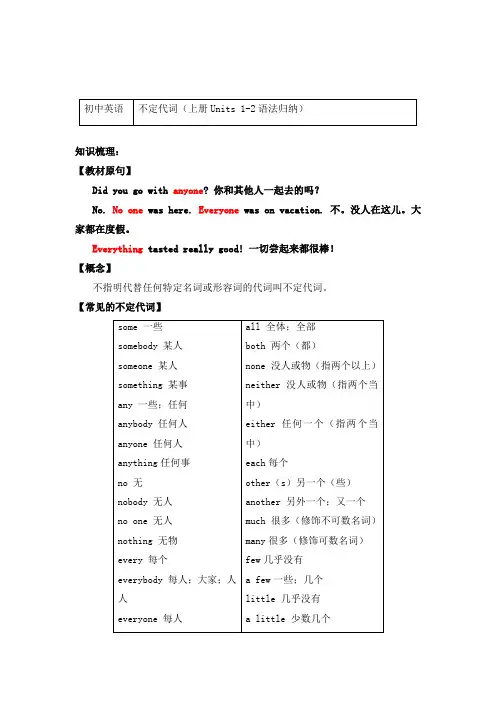
知识梳理:【教材原句】Did you go with anyone? 你和其他人一起去的吗?No. No one was here. Everyone was on vacation. 不。
没人在这儿。
大家都在度假。
Everything tasted really good! 一切尝起来都很棒!【概念】不指明代替任何特定名词或形容词的代词叫不定代词。
【常见的不定代词】everything 每件事;一切1. some系列的词主要用于肯定句中;any系列的词主要用于疑问句、否定句中。
它们都既可修饰可数名词,也可修饰不可数名词。
【例句】There is something wrong with her. 她生病了。
There isn’t anyone in the classroom. 教室里没有人。
提示:在Would you like sth.?一类的问句中用some,不用any。
2. 由some, any, no, every构成的复合不定代词作主语时,谓语动词用第三人称单数形式。
【例句】Everyone in China likes the Spring Festival. 在中国,人人都喜欢春节。
3. 形容词修饰不定代词时,通常放在不定代词的后面。
【例句】Please do something special. 请做些特别的事情吧。
4. 几组不定代词的区别:① both, either, neither这三个词都指两者,both表示“两者都”,either表示“两者中的任何一个”,neither表示“两者都不”。
【例句】—Which do you like better, tea or coffee? 你更喜欢哪个,茶还是咖啡?—Neither, I like water better. 两者都不,我更喜欢水。
② a few; few;a little; little★ a few, few用来修饰可数名词,a little, little用来修饰不可数名词。
人教版英语:八年级上册各单元必考知识点汇总
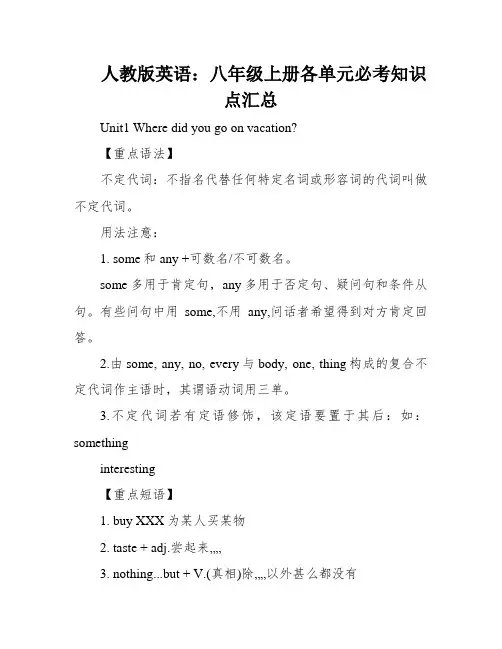
人教版英语:八年级上册各单元必考知识点汇总Unit1 Where did you go on vacation?【重点语法】不定代词:不指名代替任何特定名词或形容词的代词叫做不定代词。
用法注意:1. some和any +可数名/不可数名。
some多用于肯定句,any多用于否定句、疑问句和条件从句。
有些问句中用some,不用any,问话者希望得到对方肯定回答。
2.由some, any, no, every与body, one, thing构成的复合不定代词作主语时,其谓语动词用三单。
3.不定代词若有定语修饰,该定语要置于其后:如:somethinginteresting【重点短语】1. buy XXX为某人买某物2. taste + adj.尝起来……3. nothing...but + V.(真相)除……以外甚么都没有4. seem + (to be) + adj看起来5. XXX抵达某地6. XXX do XXX决定做某事7. try doing sth.测验考试做某事/ try to do sth.极力做某事8. XXX喜欢做某事9. want to do sth.想去做某事10. XXX.入手下手做某事=XXX.11. stop XXX截止做某事辨别:stop to do sth.停下往来来往做某事12.XXX XXX.不喜欢做某事14.so + adj + that +从句如此……以至于……16. tell sb. (not) to do sth.告诉某人(不要)做某事17. keep XXX继续做某事18. forget to do XXX.忘记去做某事XXX忘记做过某事【词语辨析】1.XXX拍照quite a few+名词复数“很多…”2. seem +描绘词看起来…... You seem happy today.XXX.似乎/好像做某事I seem to have a coldIt seems +从句似乎..….It XXX.seem like ...好像,似乎…..It seems like a good idea.XXX小地址(注:若后跟地点副词XXX,介词需省略,如:arrive here;get home)4. XXX感觉像…XXX.想要做某事5. wonder(想知道)+疑问词(who, what, why)引导的从句。
人教版英语八年级上册Unit1复合不定代词精讲及考点解析
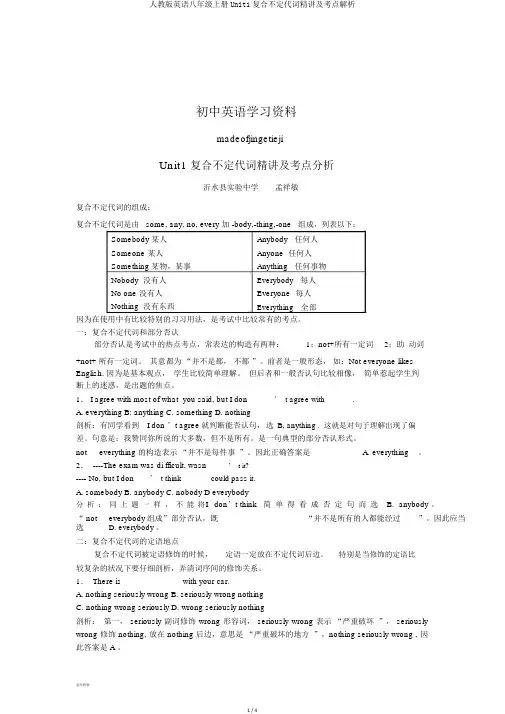
初中英语学习资料madeofjingetiejiUnit1 复合不定代词精讲及考点分析沂水县实验中学孟祥敏复合不定代词的组成:复合不定代词是由 some, any, no, every 加 -body,-thing,-one 组成,列表以下:Somebody 某人Anybody 任何人Someone 某人Anyone 任何人Something 某物,某事Anything 任何事物Nobody 没有人Everybody 每人No one 没有人Everyone 每人Nothing 没有东西Everything 全部因为在使用中有比较特别的习习用法,是考试中比较常有的考点。
一:复合不定代词和部分否认部分否认是考试中的热点考点,常表达的构造有两种:1:not+所有一定词2:助动词+not+ 所有一定词。
其意都为“并不是都,不都”。
前者是一般形态,如:Not everyone likesEnglish. 因为是基本观点,学生比较简单理解。
但后者和一般否认句比较相像,简单惹起学生判断上的迷惑,是出题的焦点。
1. I agree with most of what you said, but I don’ t agree with ______.A. everything B: anything C. something D. nothing剖析:有同学看到I don ’t agree就判断能否认句,选B, anything .这就是对句子理解出现了偏差。
句意是:我赞同你所说的大多数,但不是所有。
是一句典型的部分否认形式。
not everything 的构造表示“并不是每件事”。
因此正确答案是 A. everything。
2. ----The exam was di fficult, wasn’ t it?---- No, but I don’ t think ______ could pass it.A. somebodyB. anybodyC. nobody D everybody分析:同上题一样,不能将I don’t think简单得看成否定句而选 B. anybody 。
人教版八年级上册英语各单元语法
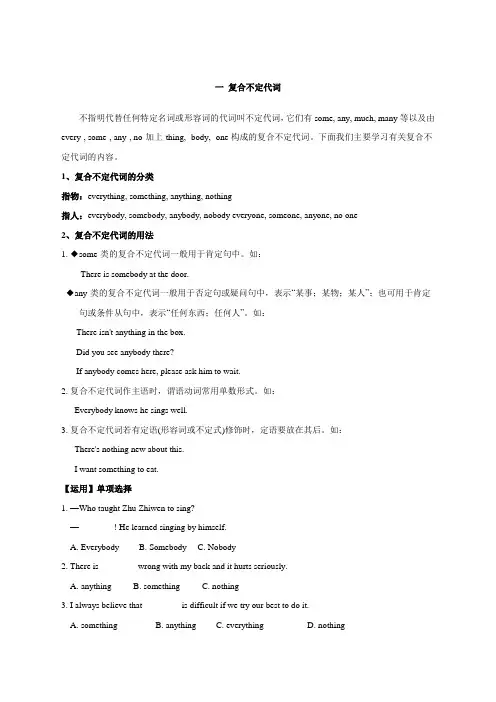
一复合不定代词不指明代替任何特定名词或形容词的代词叫不定代词,它们有some, any, much, many等以及由every-, some-, any-, no-加上-thing, -body, -one构成的复合不定代词。
下面我们主要学习有关复合不定代词的内容。
1、复合不定代词的分类指物:everything, something, anything, nothing指人:everybody, somebody, anybody, nobody everyone, someone, anyone, no one2、复合不定代词的用法1. ◆some-类的复合不定代词一般用于肯定句中。
如:There is somebody at the door.◆any-类的复合不定代词一般用于否定句或疑问句中,表示“某事;某物;某人”;也可用于肯定句或条件从句中,表示“任何东西;任何人”。
如:There isn't anything in the box.Did you see anybody there?If anybody comes here, please ask him to wait.2. 复合不定代词作主语时,谓语动词常用单数形式。
如:Everybody knows he sings well.3. 复合不定代词若有定语(形容词或不定式)修饰时,定语要放在其后。
如:There's nothing new about this.I want something to eat.【运用】单项选择1. —Who taught Zhu Zhiwen to sing?—________! He learned singing by himself.A. EverybodyB. SomebodyC. Nobody2. There is ________ wrong with my back and it hurts seriously.A. anythingB. somethingC. nothing3. I always believe that ________ is difficult if we try our best to do it.A. somethingB. anythingC. everythingD. nothing4. —Would you please tell me ________ in today's newspaper?—Sorry, I haven't read it yet.A.something importantB. important somethingC. anything importantD. important anything5. —Is there ________ in today's newspaper?—Yes. A terrible accident happened in Hubei.A. special somethingB. anything specialC. something special6. When our teacher heard of the news, he was too angry to say ________.A. everythingB. nothingC. somethingD. anything二频度副词频度副词表示事情发生的频率。
专题02重点语法一:不定代词和反身代词八年级英语上册期中考点大串讲(人教版)(解析版)
专题10 重点语法一:不定代词和反身代词1.________ of the two movies are wonderful. I hope to see them again.A.All B.Both C.None【答案】B【详解】句意:这两部电影都很精彩。
我希望能再看它们。
考查代词辨析。
All三者及以上都;Both两者都;None一个都不。
根据“I hope to see them again.”可知,希望再看,所以是好看的,结合“two movies”可知,是两部电影。
故选B。
2.Last night, Alex had ________ to do, so he went to bed early and had a good sleep.A.anything special B.everything important C.nothing much【答案】C【详解】句意:昨天晚上,亚历克斯没有什么事情要做,所以他早早上床,睡了个好觉。
考查复合不定代词辨析。
anything special任何特殊的事情;everything important一切重要的事情;nothing much 没什么事情。
根据“so he went to bed early and had a good sleep.”可知,应该是晚上“没有什么事做”,排除B 选项;A选项用于否定句,故选C。
3.—Can you speak Chinese, Jane?—Yes, but only ________. I came to China two weeks ago.A.a little B.little C.a few D.few【答案】A【详解】句意:——简,你会说汉语吗?——是的,但只会一点点。
我两周前来到中国。
考查代词辨析。
a little一点,修饰不可数名词;little几乎没有,修饰不可数名词;a few几个,修饰复数名词;few几乎没有,修饰复数名词。
不定代词知识点详解及练习(初中英语专题复习)
Not all books are good.(= All books are not good. 不是所有的书都是好书。
知识拓展:all作主语,指代人时,谓语动词使用复数形式,指代事情时,谓语动词一般使用单数;作同位语时,all在句中的位置与both相同。
(5)复合不定代词的用法
由some,any,every,no与one,body,thing一起构成的代词叫复合不定代词,如something,everybody,anyone,nothing等。由one和body构成的复合不定代词可相互换用。
用法
例句
复合不定代词一般用作单数,在句中作主语、宾语或表语
If you have any questions, please ask me. 如果你有问题,可以问我。
Any child needs love. 任何一个孩子都需要爱。
some和any可以用来修饰单数名词,some表示"某一";any表示"任何的"
Any student can answer this question. 任何学生都可以回答这个问题
some多用于肯定句;在表示请求、劝告、邀请、或不希望对方拒绝的疑问句中用some而不用any
Some of the boys are good at swimming. 一些男孩擅长游泳。
Will you give me some water? 请给我一些水好吗?
any多用于疑问句、否定句和条件状语从句中;用于肯定句中,表示"任何"
little不多,没有什么
知识拓展:
初中英语代词知识点:不定代词注意要点诠释
初中英语代词知识点:不定代词注意要点诠释不定代词,是英语语法术语,在句中可以作主语、宾语、表语、定语和状语。
不定代词是不指明代替任何特定名词或形容词的代词。
下面是小编为您收集整理的初中英语代词知识点:不定代词注意要点诠释,供大家参考!初中英语代词知识点:不定代词注意要点诠释1. some和any的比较不定代词some,any都是"一些"的意思,都可和可数名词或不可数名词连用。
some一般用于肯定句中;而any则用于否定句、疑问句或条件从句中。
例:Tom has some picture——books.汤姆有几本图画书。
I have waited some time.我已等了一会儿了。
Have you any questions?你有问题吗?There aren't any pictures on the wall.墙上没有图片注意:在表示请求、邀请或征求意见的句子中,通常要用some 而不用any。
如:Will you lend me some money? 可以借些钱给我吗?Why don't you bring some flowers? 为什么不带些花来呢?2. 指两者和三者的不定代词。
有些不定代词用于指两者(如both,either,neither),有的不定代词用于指三者(如all,any,none,every),具体使用时要根据一定的上下文正确选用。
如:He is blind in both eyes. 他双目失明。
Were they all college students? 他们都是大学生吗?注:each 可用于两者、三者或三者以上,而every 只用于三者或三者以上,因此用于两者时只能用each,不能用 every。
如:There are trees on each side of the road. 路的两边都有树。
3. (a)few 与(a)little。
不定代词(知识点详解)(22张PPT)初中英语专题复习
如: 这件衬衫太大了;我试件别的。
I want to have another two apples.
我想再要两个苹果。
the other是指两个中的另一个人或者事物,经常和one连用, 构成one… the other结构,表示“(两个中)一个……, 另 一个……”。
everything的意思是 “每件事物”,主要 用于肯定句中,在否 定句中表示部分否定。
如: Your teacher has already told me everything about your family.
你的老师把你家庭的 一切事情都告诉了我。 I don’t know everything about him. 我并不知道他的 每一件事。
6
many,much
不明确指代某个(些)人或某个(些)事物的代词叫不定 代词。
掌握不定代词要注意其表示肯定还是否定;用于肯定句还 是疑问句或否定句;表示两者还是三者或三者以上;弄清 楚几组不定代词的区别。
a few, a little, few, little
little和little经常用来修饰或 者代替不可数名词。
the other,others, the others, another
others 表示泛指其他的人或者事 物(但不一定是剩下的全部)。
如:
Some boys are cleaning the door, some are sweeping the floor, and others are playing outside. 一些男孩在擦门,一些男孩在 扫地,其他的在外面玩。
nothing的意思是“没有任何事物”,是表示否定意义的不定代词。 如: I did nothing for your exam. 对你的考试我什么事情也没有做。 【注】形容词修饰something, anything, everything, nothing等时,要放在不定 代词后面。 如: I have something important to deal with. 我有重要的事要处理。
- 1、下载文档前请自行甄别文档内容的完整性,平台不提供额外的编辑、内容补充、找答案等附加服务。
- 2、"仅部分预览"的文档,不可在线预览部分如存在完整性等问题,可反馈申请退款(可完整预览的文档不适用该条件!)。
- 3、如文档侵犯您的权益,请联系客服反馈,我们会尽快为您处理(人工客服工作时间:9:00-18:30)。
TeachingDifficulties
1.>不定代词的用法复合不定代词包括
something,somebody,someone,anything,anybody,anyone,nothing,nobody,noone,ev erything,everybody,everyone等。
它们在句中可用作主语、宾语或表语,但不能用作定语。
something,someone等和anything,anyone等的区别与some和any的区别一样,前者一般用于肯定句,后者一般用于否定句、疑问句或条件句(参见any&some)。
具体使用时应注意以下几点:
1.复合不定代词受定语修饰时,定语应放在它们后面:
Thereisnothingwrongwiththeradio.这收音机没有毛病。
Haveyouseenanyone[anybody]famous?你见过名人吗?
2.指人的复合不定代词若用作主语,其谓语动词一般用单数,相应的人称代词和物主代词也用单数he,him,his(不一定指男性)。
但在非正式文体中常用复数代词they,them,their:
Everyoneknowsthis,doesn’the[don’tthey]?人人都知道这一点,不是吗?
Ifanybody[anyone]comes,askhim[them]towait.要是有人来,让他等着。
3.指事物的复合不定代词若用作主语,谓语动词只能用单数,相应的人称代词也只能用it,而不用they:
Everythingisready,isn’tit?一切都准备好了,是吗?4.anyone,everyone等只能指人,不能指物,且其后一般不接of短语。
若是指物或后接of短语,可用anyone,everyone(分开写):anyoneoftheboys(books)孩子们(书)当中的任何一个(本)everyoneofthestudents(schools)每一个学生(一所学校)2>seem的用法。
seem+形容词看起来…..Youseemhappytoday.
seem+todosth.似乎、好像做某事Iseemtohaveacold
Itseems/seemed+从句看起来好像…;似乎….Itseemsthatnoonebelieveyou.
seemlike….好像,似乎…..Itseemslikeagodidea.
1/ 1。
